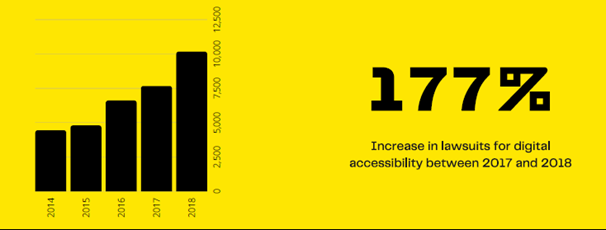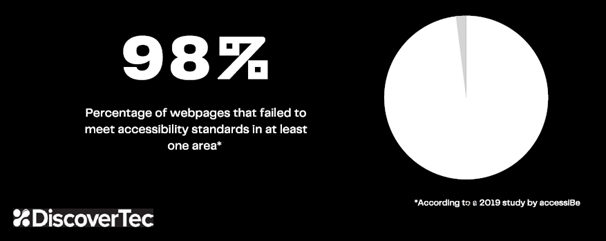According to the Centers for Disease Control, 26% (more than 1 in 4) of Americans are considered to have some form of disability. The fact of the matter is the disabled are your customers and part of your online audience. If your website is not accessible, you're not only hurting your business’ reputation and sales, but you are also creating barriers for potential customers when they are trying to access your information.
Internet accessibility has been around for over 20 years and was for most companies an afterthought and more of a “best practice” instead of a necessity. Over the last five years, web accessibility lawsuits have skyrocketed, costing businesses millions in settlements and damaging their reputations. In most cases, businesses’ have remained woefully unprepared and are beginning to face litigation regularly for failing to make their websites accessible.
This article will help you gain a foundational understanding of what accessibility compliance is and what actions you should consider taking for your online presence.
What’s Considered A Disability?
Let’s start by briefly describing what is classified as a disability. There are five disability categories:
- Visual Disability
Color blindness, limited vision, and without vision - Hearing Disability
Limited hearing, without hearing - Speech Disability
limited speech, without speech - Motor Skills Disability
Limited reach or strength, limited motor function, unable to manipulate - Cognitive Impairment
Learning disability, traumatic brain injury, photosensitive epilepsy
These categories are purposely broad to account for degrees of disability and impairment, recognizing that some are permanent, some may be temporary, and some individuals may have disabilities across multiple categories.
What is Accessibility Compliance?
Guidelines and criteria for websites, applications, and most other digital content, have been set by the World Wide Web Consortium (W3C) and the US federal government under the Rehabilitation Act and the Americans With Disabilities Act.
These latest standards are known as WCAG 2.1 (Web Content Accessibility Guidelines) [link to: https://www.w3.org/WAI/standards-guidelines/wcag/glance/ ] for the private sector and Section 508 (link to: https://www.section508.gov/manage/laws-and-policies )for the public sector. These standards for accessibility compliance cover interactive technology used online and apply to the following:
- Websites and Mobile Apps
- Videos
- Emails
- Software
- Documents made available online such as:
- PDFs
- PowerPoint Presentations
- Word Docs
- Excel files
If all of your electronic and information technology adheres to WCAG 2.1 or Section 508 criteria, you are considered accessibility compliant.
Why You Should Care
Chances are someone in your business’ target audience is disabled. They want to buy from you, and they have the spending power to do so. But if your website isn’t compliant, it creates barriers for a person to do business with you.

You could also face litigation if your website or online materials are not accessibility compliant. The harsh reality is lawsuits have been dramatically increasing over the last several years.

For many businesses, litigation begins with a demand letter from an attorney that includes how and where your website has failed to be compliant. In some cases, you may also be given the offer of “settling” for a fee. Settlement fees typically start in the tens of thousands of dollars range. The most important thing to understand is that if you receive a demand letter, you must respond. That means paying to retain legal counsel along with time and stress considering your options. These types of lawsuits can be devastating to small businesses, even if they avoid going to court.
Furthermore, once you are targeted for litigation, you will still need to go through the expense of bringing your website into compliance no matter what.
There is a financial upside in investing in your online presence accessibility, and there’s a potentially significant financial downside if you do not.
What Can You Do?
The first place to start is testing. You need to test your site to see if you are in compliance. There are free automated tools available, but they will not test for everything. You need to be thorough when testing and, you should have your website tested by certified professionals that can review their findings with you.
Chances are if you think you are in compliance but don’t know for sure, you’re probably not.

You should also educate yourself during the process. There are many complexities to accessibility compliance, and the guidelines get updated every few years to keep up with new technologies.
Getting Compliant
After thorough testing and review, you’ll need to start fixing or “remediation” as the industry term goes. Remediation can become costly depending on the complexity and scope of the issues. Still, with a skilled partner to help you, it’s possible to prioritize what must be done, make the right decisions and begin the work.
Accessibility compliance should become a permanent part of your online efforts sooner rather than later, not only because it’s the law and you’ll want to avoid litigation, but because it’s also the right thing to do.
And if you are still unsure where to begin or just have some questions, DiscoverTec has certified accessibility compliance experts that can help. Reach out to us at accessibility@discovertec.com